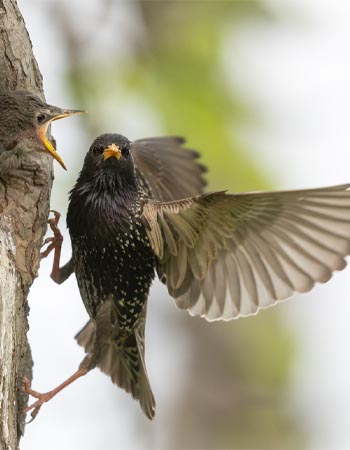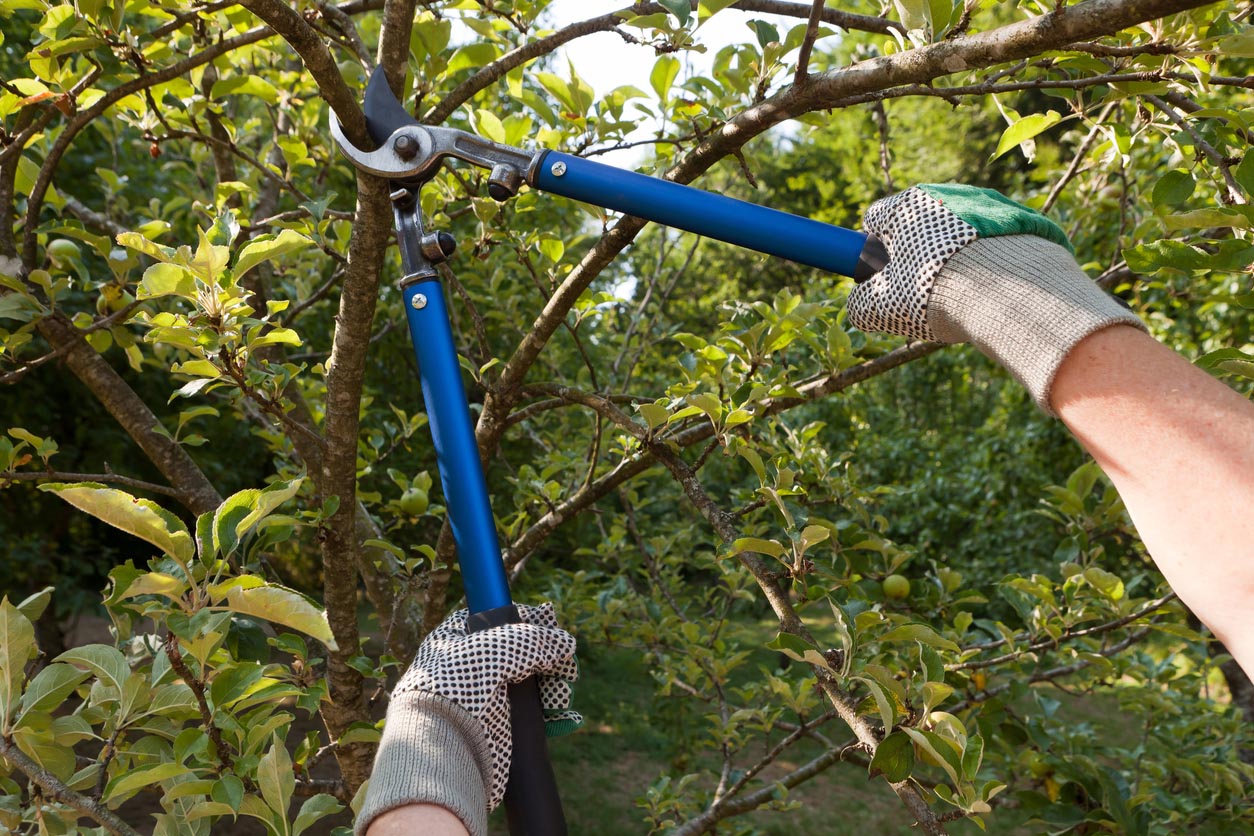

We may earn revenue from the products available on this page and participate in affiliate programs. Learn More ›
The starling bird is an invasive, sometimes aggressive species. These birds can wreak havoc on your yard, drive away other types of birds, and disrupt residents with their loud shrieks—which is why it’s essential to know how to get rid of starlings. In most cases, you can try common tactics such as removing food sources, decreasing nesting spots, using the best bird deterrents, and closing any access points. Still, if your starling problem persists, it may be time to call a professional wildlife removal specialist. Because starlings can be aggressive toward other birds and are sometimes challenging to get rid of, it’s important to remove starlings from your property as soon as possible.
Time required: 1 to 2 weeks
Difficulty: Beginner
Estimated cost: $20 to $75
Tools & Materials
Bobvila.com may earn a commission from purchases made through these links.
- Starling-proof bird feeder
- Pruning shears
- Protective gloves
- Holographic bird deterrent
- Flexible bird spikes
Before You Begin…

Before you inspect your yard or stock up on deterrents, it helps to better understand starlings, from their nesting habits to their behaviors and food sources. Once you know more about them and how they’re inhabiting your yard, you can decide which tool or technique is best to get rid of them. It’s also important to remember that there may be regulations regarding removing or destroying their nests, as the Migratory Bird Treaty Act of 1918 may protect some birds. It’s a good idea to leave that task to a wildlife removal specialist who will be familiar with these regulations.
Tips for How to Get Rid of Starlings
- Install a starling-proof bird feeder.
- Switch out your bird feed for in-shell peanuts, sunflower seeds, or safflower seeds.
- Prune trees to limit nesting.
- Install deterrents on your roof to keep the birds at bay.
- Close any small holes that could serve as entry points to the home.
- Call a professional wildlife removal specialist.
Safety Considerations
Birds, nests, and feces can transmit pathogens like E. coli, salmonella, and fungi that can lead to serious fungal infections. Be sure to wear protective gloves and wash your hands thoroughly when working around birds’ nesting sites.
An improperly placed bird’s nest can be a fire hazard, so it’s prudent to get a starling problem under control as soon as possible, especially if birds have made a nest on or in your house.
STEP 1: Swap your backyard feeder for a starling-proof feeder, and choose foods that starlings don’t like.
The first line of defense in getting rid of starlings is to install a starling-proof bird feeder. A starling-proof feeder features a standard feeder tube with a cage around it so that larger animals or birds can’t access the seed inside. It helps to use a feeder with a cage diameter of at least 11 inches, so it’s impossible for starlings (or other animals like squirrels) to stick their heads through the cage to retrieve seeds. Then you can put the feeder in the best spot to watch the birds you actually want in your yard.
Another way to keep starlings from coming into your yard is to switch up the bird feed to options that don’t appeal to them. What do starlings eat? They’re omnivorous and will go for insects, fruits, and nuts. They’re also fond of cracked-corn bird feed. But because starlings have soft beaks, they cannot eat tougher nuts and seeds such as in-shell peanuts, sunflower seeds, or safflower seeds. These food options still appeal to a wide range of birds, but since they don’t appeal to starlings, they are less likely to come around if their preferred food source is gone.

STEP 2: Prune trees to limit starlings’ roosting space.
Another effective way to keep starlings at bay is to prune your trees regularly. Whether you have decorative or fruit trees, their branches are easy for these species of birds to access and build a starling nest. Starlings typically form large flocks and brood two or three times per year, so they need lots of room for all the birds in the flock to roost. Reducing your branch density makes starlings less likely to camp out in your yard. Thinned-out branches make the birds feel more vulnerable to attacks from predators, so pruning is a simple task that goes a long way when you need to know how to keep birds from building a nest. Conversely, smaller birds will still feel comfortable with less branch cover.
Be careful when pruning trees not to disrupt any existing bird nests. If you don’t feel confident pruning your own trees, you can always hire a local arborist to prune branches for you.
STEP 3: Use a nesting deterrent on the roof, and patch any holes that starlings might be able to access.
A common, effective tool to keep starlings from nesting on the roof is a bright, inflatable balloon with holographic eyes that convinces the birds they’re being watched and scares them away. The balloon is attached to a spring that allows it to move, so it’s more effective than a stationary fake owl or scarecrow. Holographic tape can also be an effective way to keep birds off the roof, as it scatters light and makes it difficult for birds to land. Flexible bird spikes can also deter birds from landing on the roof. The soft plastic spikes make it uncomfortable for birds to land but won’t harm the birds.
Since starlings are cavity nesters, they’re likely to build a nest in small vents or openings around the house. Starlings can fit in any holes that are 1.5 inches in diameter or larger, so it’s wise to fill any holes or gaps in your home’s exterior. Mesh wire is a standard choice for filling these holes, but opt for the best material for the hole’s size and location. A wildlife removal specialist will be skilled in making these types of repairs, so reach out to a local professional if you’re unsure how to seal any gaps.
STEP 4: Consider noise deterrents to discourage starlings.
Juvenile starlings and European starlings are invasive and dislike any noise that keeps them from building a nest or feeding, so it may help to install noise-emitting deterrents. You can mount noise deterrents to your roof, eaves, or similar spaces where starlings like to roost. These deterrents release an ultrasonic noise whenever they detect movement.
Some of these devices emit a frequency that makes birds confused or disoriented, so you’ll need to make sure you select the correct audio frequency for starlings. You should also be aware that some frequencies can be damaging to other bird species, so you may inadvertently scare them away from your yard.

STEP 5: Hire a professional wildlife removal specialist to effectively keep starlings from the yard or home.
When you need to know how to get a bird out of your house or yard, there’s no better expert to call than a professional wildlife removal specialist. Whether you have a hefty population of starlings or you’ve tried all the above steps to no avail, these pros will know how to get rid of grackles or starlings in no time. These pros rely on not only their years of experience but also their knowledge of bird species and know how to stop birds from building a nest. From installing a starling trap to inspecting potential entry points or removing birds from specific areas, a wildlife removal specialist is your best bet when you need to get rid of unwanted starlings.
Whether you have a few ornery starlings or a whole flock, starlings can be a nuisance at best and a danger at worst. Regardless of how pervasive the issue is, a wildlife removal specialist can help you get rid of starlings. These professional services may even come with a guarantee that a technician will return if the starlings come back to your yard.
FAQs
It can be tricky to figure out how to get rid of starlings without scaring off the whole bird population. These frequently asked questions can help you determine the habits of this species and the best way to get rid of them without deterring your friendly cardinal, blue jay, or other less-invasive visitors.
Q. How do you get rid of starlings but not other birds?
To get rid of starlings but not deter other birds, you can replace your bird feeder with a starling-proof option, switch your feed to foods they dislike (including in-shell peanuts, sunflower seeds, and safflower seeds), and trim your trees.
Q. What smell keeps starlings away?
Wondering, “What smell do birds hate?” Peppermint oil is typically pretty offensive to starlings but will likely also deter most species of birds other than starlings too.
Q. Do starlings scare off other birds?
Starlings can often become aggressive toward other birds to keep them away from feeders or nesting spots. Since they travel in large flocks, they can push out other species from their food source. The starling call is loud, which can discourage other birds from approaching.
Q. What foods deter starlings?
Whole peanuts, safflower seeds, sunflower seeds, nectar, and Nyjer (thistle) seed are less appealing to starlings and can help deter them. Starlings have soft beaks and often can’t break through nuts and seeds with more-rigid shells.
Q. How do I stop starlings nesting under roof tiles?
A few ways to keep starlings from nesting under roof tiles include installing tile roof eave closures, using a sound deterrent, or installing holographic deterrents.
Q. What time of year do starlings nest?
Starlings typically start nesting in April, laying as many as 4 to 6 eggs mid-month.
